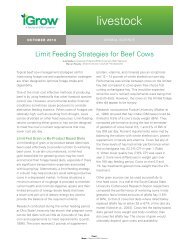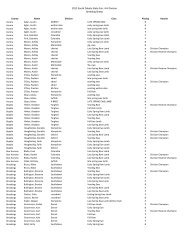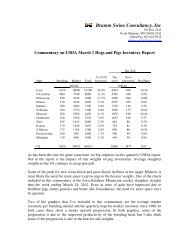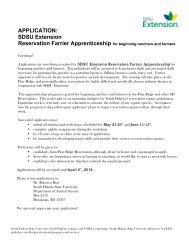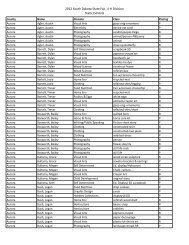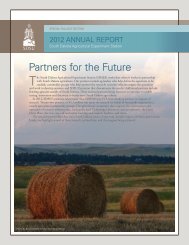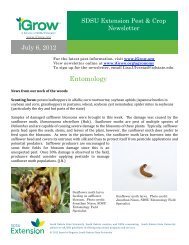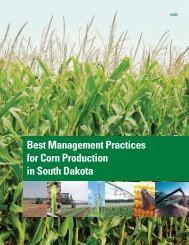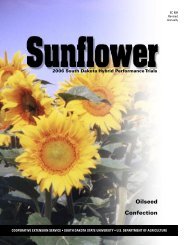Best Management Practices for Corn Production in South Dakota
Best Management Practices for Corn Production in South Dakota
Best Management Practices for Corn Production in South Dakota
You also want an ePaper? Increase the reach of your titles
YUMPU automatically turns print PDFs into web optimized ePapers that Google loves.
<strong>Corn</strong> root aphid description<br />
<strong>Corn</strong> root aphids are plump, yellow-green to bluegreen<br />
<strong>in</strong>sects, about 1/16-<strong>in</strong>ch long when fully grown<br />
(fig. 8.19). They have syr<strong>in</strong>ge-like mouthparts to withdraw<br />
sap from the roots. <strong>Corn</strong> root aphids are usually<br />
found underground, clustered around the roots of corn<br />
plants. Individual aphids can either be w<strong>in</strong>ged or w<strong>in</strong>gless,<br />
with the <strong>for</strong>mer usually darker <strong>in</strong> color than the<br />
latter. Stunted and yellowish corn seedl<strong>in</strong>gs, along with<br />
the presence of numerous cornfield ants and ant nests,<br />
may be signs of corn root aphid <strong>in</strong>festations (fig. 8.20).<br />
<strong>Corn</strong> root aphid biology<br />
<strong>Corn</strong> root aphids spend much of their time<br />
underground, feed<strong>in</strong>g on the sap of corn roots. The<br />
honeydew that aphids excrete is used by cornfield ants<br />
as food. There is a symbiotic relationship between the<br />
ants and aphids. Aphids supply food to the ants, while<br />
the ants protect and transport the aphids. Although<br />
the corn root aphid is capable of <strong>for</strong>m<strong>in</strong>g w<strong>in</strong>gs, its<br />
dispersion is aided by cornfield ants. <strong>Corn</strong> root aphids<br />
overw<strong>in</strong>ter as eggs that are cared <strong>for</strong> by cornfield ants<br />
<strong>in</strong> their nests. These eggs hatch <strong>in</strong> the spr<strong>in</strong>g and are<br />
carried by ants to the roots of acceptable available<br />
plants such as smartweed, wheat, and corn. Aphids can<br />
also be carried by the ants from weeds to corn later <strong>in</strong><br />
the season. Like most aphid species, corn root aphids<br />
multiply very fast and complete their life cycles from<br />
nymphs to adults with<strong>in</strong> a week. W<strong>in</strong>ged aphids may<br />
Figure 8.19. <strong>Corn</strong> root aphid adults and nymphs<br />
(Photo courtesy of He<strong>in</strong>richs et al.)<br />
Figure 8.20. Suspected area (due to numerous ant<br />
nests present and corn <strong>in</strong>jury symptoms) of corn<br />
root aphid <strong>in</strong>festation<br />
(Photo courtesy of Roger Barrick, <strong>South</strong> <strong>Dakota</strong> State University)<br />
be produced when a colony becomes overcrowded. High numbers of aphids withdraw<strong>in</strong>g sap from the<br />
roots of corn seedl<strong>in</strong>gs may result <strong>in</strong> the stunt<strong>in</strong>g and yellow<strong>in</strong>g of corn leaves (fig. 8.20).<br />
<strong>Corn</strong> root aphid management<br />
There are currently no economic thresholds or <strong>in</strong>secticides available <strong>for</strong> use aga<strong>in</strong>st corn root<br />
aphids on corn <strong>in</strong> <strong>South</strong> <strong>Dakota</strong>.<br />
<strong>Corn</strong> Leaf Aphid (Rhopalosiphum maidis)<br />
Pest highlights<br />
Figure 8.21. <strong>Corn</strong> leaf aphid adults and nymphs<br />
<br />
and develop<strong>in</strong>g ears.<br />
<br />
poll<strong>in</strong>ation, and ear development.<br />
<br />
corn leaf aphids.<br />
<br />
other pests, such as molds and sap beetles.<br />
<strong>Corn</strong> leaf aphid description<br />
(Photo courtesy of Jon Kieckhefer, <strong>South</strong> <strong>Dakota</strong> State University)<br />
Bluish-green w<strong>in</strong>gless and w<strong>in</strong>ged corn leaf aphids<br />
range <strong>in</strong> size from 1/16 to 1/8 <strong>in</strong>ch (fig. 8.21); both<br />
w<strong>in</strong>gless and w<strong>in</strong>ged <strong>for</strong>ms may be present. <strong>Corn</strong> leaf<br />
aphids can usually be found <strong>in</strong> the whorl, tassel, develop<strong>in</strong>g ears, and upper leaves. Heavily <strong>in</strong>fested<br />
plants may appear “messy” or “sticky” (fig. 8.22).<br />
CHAPTER 8: <strong>Corn</strong> Insect Pests 57



